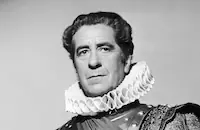Midnight Alibi

Brief Synopsis
Cast & Crew
Alan Crosland
Richard Barthelmess
Ann Dvorak
Helen Chandler
Helen Lowell
Henry O'neill
Film Details
Technical Specs

Synopsis
On the boat back from Europe, gangster Lance McGowan meets Joan Morley without realizing that she is the sister of Angie the Ox, one of Lance's rivals. Angie, who runs several gambling clubs, has taken advantage of Lance's absence to take over as head man. Now that he has returned, Lance tries to take back his territory. He meets Joan again at Angie's biggest club, and when Angie sees them together, he warns Lance away from his sister. Angie orders his men to take care of Lance, and they shoot at him as he is leaving the club. He escapes into a large mansion across the street, which is owned by Abigail Ardsley. She greets her intruder and tells him that she has kept her door open for forty-five years, ever since her disapproving father shot and killed her fiancé, Robert Anders. When Lance tells Abigail that he is in a similar situation, she advises him not to let Joan go. Taking her advice, Lance visits Joan at home to tell her that he loves her and she admits that she loves him, too. That night Lance brings Abigail a dog to keep her company. With her encouragement, he goes to Angie's club to ask his permission to marry Joan, and when Angie reaches for his gun, Babe, one of Lance's men, kills him. Lance is blamed for the murder and is arrested, and when Babe is killed leaving town, he no longer has an alibi. A strict new governor decides to make an example of Lance, and it looks like he will be convicted until Abigail leaves her house for the first time in years and testifies that Lance was visiting her at the time of the murder. Lance is acquitted on her word. When he visits Abigail for the last time to tell her that he has gotten a good job and is going straight, he finds Joan waiting there for him.

Director

Alan Crosland
Cast

Richard Barthelmess

Ann Dvorak

Helen Chandler
Helen Lowell

Henry O'neill

Robert Barrat

Robert Mcwade
Purnell Pratt
Harry Tyler
Paul Hurst
Arthur Aylesworth

Vincent Sherman
Eric Wilton
Boothe Howard
Walter Law

Edward Keane
Allan Wood
Heinie Conklin
David Callis

Ethel Wales
Gus Reed
Tom Costello
Buck Russell

William B. Davidson
Ben Hendricks
Frank La Rue
Philip Morris
James Donlan
Charles Hickman
Carl Mcbride
Renee Whitney

Walter Walker
Milton Kibbee
Stanley Mack

Lee Phelps

Robert Warwick
Harry Seymour
Crew

Film Details
Technical Specs

Articles
Midnight Alibi -
By Glenn Erickson

Midnight Alibi -
Quotes
Trivia
Milton Kibbee is listed in studio records as "First Reporter", but he did not appear in the movie.
Notes
The film's pre-release title as The Old Doll's House. This was Richard Barthelmess' last film for Warner Bros.















